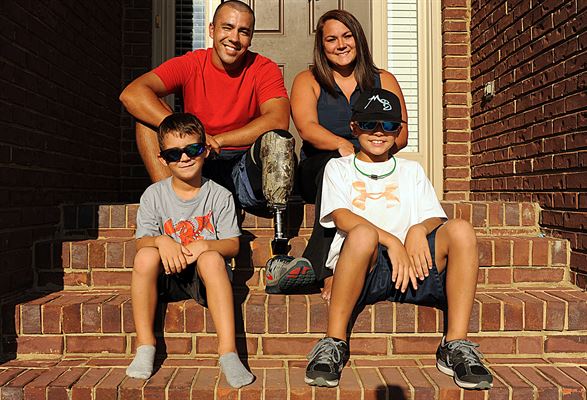 PHOTO: Air Force Staff Sgt. Rey Edenfield poses with his wife, Amy, and their two sons, Grayson, left, and Dawson on the front porch of their home, Aug. 28, 2014.MAXWELL AIR FORCE BASE, Ala., Sept. 18, 2014 – His sons say he has a robot leg. The doctors and nurses call it a prosthetic. But to Air Force Staff Sgt. Rey Edenfield, it's what has allowed him to overcome the odds and continue doing what he loves. The picture was taken almost a year after Edenfield was involved in a motorcycle accident that resulted in his left leg being amputated six inches below the knee. Edenfield is an air traffic controller at Maxwell Air Force Base, Ala. U.S. Air Force photo by Staff Sgt. Erica Picariello Edenfield was enjoying a typical day off in October when a fateful decision took his leg and threatened the course of his career. The air traffic controller decided earlier that morning to spend his day relaxing outside while slow-cooking dinner for his wife and two elementary school-aged boys at their off-base home.
PHOTO: Air Force Staff Sgt. Rey Edenfield poses with his wife, Amy, and their two sons, Grayson, left, and Dawson on the front porch of their home, Aug. 28, 2014.MAXWELL AIR FORCE BASE, Ala., Sept. 18, 2014 – His sons say he has a robot leg. The doctors and nurses call it a prosthetic. But to Air Force Staff Sgt. Rey Edenfield, it's what has allowed him to overcome the odds and continue doing what he loves. The picture was taken almost a year after Edenfield was involved in a motorcycle accident that resulted in his left leg being amputated six inches below the knee. Edenfield is an air traffic controller at Maxwell Air Force Base, Ala. U.S. Air Force photo by Staff Sgt. Erica Picariello Edenfield was enjoying a typical day off in October when a fateful decision took his leg and threatened the course of his career. The air traffic controller decided earlier that morning to spend his day relaxing outside while slow-cooking dinner for his wife and two elementary school-aged boys at their off-base home.
But he underestimated how much charcoal he'd need to finish cooking the meat the way he preferred. "I ran out of charcoal," Edenfield said. "I needed that and a couple of things. I live about a half a mile from [the store], so I hopped on my motorcycle and went to get the things that I needed." The crisp fall air and blue skies made for a suitable day for Edenfield’s ride to the store. He was wearing his motorcycle helmet. "There was a truck turning into the neighborhood," Edenfield said. "I looked behind him and didn't see any traffic. I started creeping out of my neighborhood, and as soon as I got into the center lane, I realized a car was kind of catty-corner to that truck. I had just gotten into that center lane enough to where that left bumper clipped me and smashed my left foot into my motorcycle." The impact shot him into the air and sent his bike skidding on its side across the pavement. "I sat straight up, took my helmet off and threw it out of anger,” he recalled. “I went to get up and looked down and realized that something was wrong." The impact severed the heel from his foot.
A lot of adrenaline "There was a lot of adrenaline, and in that moment I was more worried about my Air Force career because I take pride in what I do," Edenfield said. "Realizing that [my career] could possibly come to an end was really getting to me in that moment. After seeing my foot, I was freaking out. … It was between ‘My career is over’ and ‘They're going to cut my leg off.’ I didn't want to accept any of that." At the hospital, the doctor quelled any fear that his career as an air traffic controller was in jeopardy by suggesting surgery that would involve inserting a few pins and a few months of follow-up visits. "The doctors and nurses at a local hospital said it looked OK and they'd be able to put it back together," Edenfield said. "They said it was just a fracture. My Achilles tendon was fully intact, and they said everything was good. It was just the force that split my heel. They did the surgery that night, and three days later they sent me home to heal."
Something wasn’t quite right It wasn't more than a week later that Edenfield noticed something wasn't quite right with his heel. "After the first few days, I had a small black spot on the back of my heel that was about the size of a nickel," he said. "The doctor told me that spot was dead because it wasn't getting proper blood flow and circulation to my foot. He said he'd keep an eye on it, re-casted my leg and sent me home. This went on for a couple of weeks; it felt like a lot longer than that. On one of my last visits to him, I went there and my foot was almost completely black. It was dead." Doctors referred Edenfield to a specialist in Birmingham, Alabama, who scheduled a skin graft to replace the dead skin on his foot. Edenfield went into the hospital in late November for the surgery. When the doctor came in while he was in the pre-operation area, Edenfield said, he asked him if he had any questions or concerns. "I just want to wake up and still have a leg," was his reply. Edenfield did wake up with his leg, and the same dead foot. The surgery never happened, and he had a decision to make. "Once they removed all the dead skin and tissue from my foot, it was down to the bone," Edenfield said. "From what [the surgeon] said, the heel padding is so dense that it's hard to replicate it. So, at this point the only other option was to do a muscle transplant. “Similar to a skin graft,” he continued, “they were going to take muscle from somewhere else in my body and cover up my heel, and then put skin over that. I told the doctors, 'Whatever my best chances of staying in the military is what I want to do.' They brought an active-duty Air Force surgeon into the hospital to consult with me. After a small discussion with him, and prayer and discussions with my family, we decided that amputation would be the best option."
A family decision Joining the military was a family decision, so the decision to amputate would have to be a family decision, too, Edenfield said. "We asked our sons what they would prefer," he said. "We told them that they could either have daddy able to play baseball with them, still be physically active in their church and run around the yard with a metal leg, or they could have a less mobile daddy with his leg real still. They chose the 'robot leg' and mobile daddy." Edenfield's leg was amputated six inches below the knee Nov. 25. He received his prosthetic Feb. 10, and he walked unassisted three days later. "I had a slight limp, but I didn't need a cane," he said. "I had a lot of pain after that -- not normal pain, unbearable pain. I found a local prosthetic leg company that was able to adjust my prosthetic leg, and I walked out of that clinic unassisted." Though learning to walk again had to be done of his own strength and will, Edenfield said he doesn't believe he would have had the mental fortitude to recover so fast if not for his wife, Amy. "My wife helped me so much; she was by my side through the entire process," he said. "She's helped out in so many ways, and basically, for the first four months, she was a single mom -- what she's done before, with me deploying and [serving on] remote tours. She's prepared."
A positive effect This process has had a positive effect on the family, Amy said. "He has inspired us in countless ways," she explained. "He seemingly has a 'right' to mope and have people feel sorry for him. According to 'normal' people, he has the right to be waited on and have waivers, etc. [But] his mindset is, 'Now I'm going to show them that I don't need those things. … I can be just as normal if not better than normal, even with one-quarter less leg.' “It's crazy inspiring for the kids and me,” she continued. “Why would we complain about being 'Too tired to exercise' or 'Too tired to play outside' or things like that? The man lost almost half of a leg, and he doesn't aim to just get by. He aims for the best. I strive to have the same motivation." Edenfield said his resolve to do more with less isn't just a personal goal -- he has something to prove. "I work harder now more than I ever did before, because I don't want to use my accident as an excuse for subpar work ethic or fitness standards,” Edenfield said. “I want to prove to myself and to everyone else that I am still capable of doing everything I did before with an equal or better outcome. I feel that my accident has had a positive impact on my entire life, including my dedication to the Air Force, my family and my faith." On Aug. 29, Edenfield was notified that he was cleared to stay on active duty. “I love what I do for the United States Air Force and what I get to do for it every day,” he said. “I'm overjoyed and humbled to have this opportunity to continue to serve my country in this capacity.”
Written Sept. 18, 2014 By: Air Force Staff Sgt. Erica Picariello 42nd Air Base Wing
Republished and redistributed by permission of DoD.






